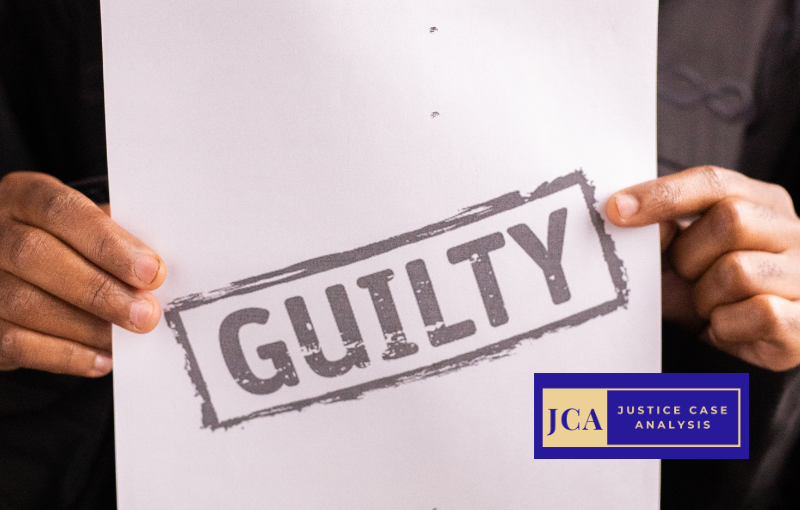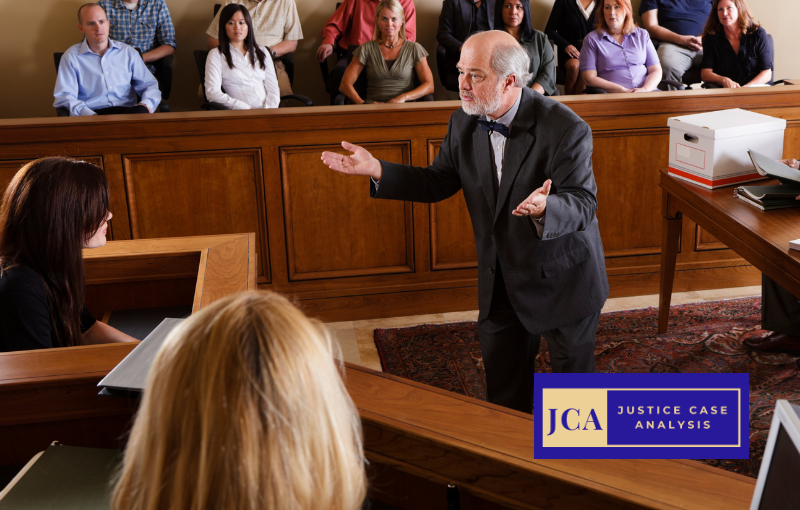
When someone is accused of a crime, the U.S. justice system operates on a powerful presumption: that the defendant is innocent until proven guilty. But what does “proven guilty” really mean? At the heart of that question lies one of the most misunderstood concepts in all of criminal law—reasonable doubt.
Let’s break it down with both legal clarity and plainspoken explanation, supported by real-world examples and landmark court cases.
📚Legal Definition of Reasonable Doubt
In U.S. criminal law, the prosecution must prove the defendant’s guilt “beyond a reasonable doubt.” This is the highest standard of proof in the legal system.
While the federal courts don’t have a single universally accepted wording, the U.S. Supreme Court in In re Winship, 397 U.S. 358 (1970), confirmed that the Due Process Clause of the Fourteenth Amendment requires proof beyond a reasonable doubt in all criminal prosecutions.
Some state courts define it explicitly. For example, the California jury instructions say:
“A reasonable doubt is not a mere possible doubt, because everything relating to human affairs is open to some possible or imaginary doubt. It is that state of the case which, after the entire comparison and consideration of all the evidence, leaves the minds of the jurors in that condition that they cannot say they feel an abiding conviction of the truth of the charge.”
🔍What Reasonable Doubt Is
Let’s look at some common examples:
A conflicting eyewitness account
If one eyewitness says the suspect was wearing a red jacket and had a beard, but another says it was a clean-shaven man in a blue hoodie, that contradiction could create reasonable doubt.
Lack of physical evidence
If the prosecution alleges a burglary, but there are no fingerprints, no surveillance footage, and no stolen items found with the defendant, a jury might reasonably doubt the claim.
Alibi evidence
If the defendant presents credible proof they were in another city when the crime occurred, and the prosecution fails to disprove it, that’s a strong foundation for reasonable doubt.
Inconsistent or coerced confession
A confession given after many hours of interrogation without a lawyer might not be reliable. If other evidence doesn’t support it, a juror could reasonably doubt its truth.
🧠Layman’s Definition: Making It Plain
In everyday terms, reasonable doubt means you aren’t convinced “to a moral certainty” that the defendant committed the crime.
Think of it like this: Would you be willing to bet something precious—your job, your reputation, even your freedom—on the belief that the person is guilty? If you’re hesitating because something just doesn’t add up, that’s reasonable doubt.
But if your doubt is wild or speculative—like aliens framed the defendant—it’s not reasonable.

🚫What Reasonable Doubt Is Not
“I just have a feeling.”
Gut instincts are not evidence. If you believe someone looks guilty or has a criminal record, that’s not enough.
“There’s a tiny possibility they didn’t do it.”
There is always some uncertainty in life. If jurors required absolute certainty, no one could ever be convicted.
“The defense didn’t prove they were innocent.”
That’s not their job. The burden of proof lies entirely with the prosecution.
Speculative doubt
Imagining bizarre or implausible scenarios—like an identical twin doing the crime unless proven otherwise—is not reasonable.
📊 “Likely Did It” Is Not Enough
In criminal law, “likely” did it is not enough to convict. The standard is beyond a reasonable doubt, not beyond a possible doubt or more likely than not. Here’s how this breaks down:
“Probably did it” or “more likely than not” = civil court standard (preponderance of evidence, just over 50%)
“Almost certainly did it” = getting closer to beyond a reasonable doubt
“No reasonable doubt remains” = criminal court standard
So, when jurors say, “I think the defendant likely did it,” they are acknowledging doubt—and if that doubt is reasonable, they must vote not guilty.
Think of it this way:
If you were about to make a life-altering decision—like undergoing risky surgery or jumping out of a plane—you wouldn’t go forward based on likelihood. You’d want strong assurance that it’s the right move. That’s how seriously the law treats taking away someone’s liberty or life.

🧑⚖️Jury Instructions and the Human Factor
Jurors are human. Some might expect “CSI”-level forensics. Others might be swayed by emotion or bias. That’s why proper instruction on reasonable doubt is vital.
Many judges remind jurors that:
It’s not enough to think the defendant probably did it.
It’s okay to acquit even if you’re not 100% sure—if your doubt is honest and reasonable.
You must put aside personal feelings and evaluate only the evidence presented in court.
💡“Reasonable” Means Reasonable
Let’s emphasize a key word: reasonable. It’s not “perfect,” “unshakable,” or “imaginary.” It’s a doubt based on logic, experience, and the evidence—or lack of it.
It doesn’t mean jurors should invent wild theories. It means they should ask: “Do I believe the prosecution has given me enough evidence to overcome doubt that a reasonable person would have?”
If the answer is no, the verdict must be not guilty.

⚖️Key Supreme Court Cases on Reasonable Doubt
In re Winship (1970): As mentioned earlier, this case established that the “beyond a reasonable doubt” standard is a constitutional requirement in criminal trials.
Victor v. Nebraska, 511 U.S. 1 (1994): The Court evaluated jury instructions on reasonable doubt and emphasized that while absolute clarity in the definition is difficult, the term must not be diluted or misunderstood. Justice Sandra Day O’Connor explained that jurors must be left with an “abiding conviction to a moral certainty.”
Cage v. Louisiana, 498 U.S. 39 (1990): The Court struck down a jury instruction that equated reasonable doubt with “grave uncertainty,” saying that such language could mislead jurors into requiring a lower standard of proof.
These cases collectively stress that the instruction must guide jurors toward a high threshold for conviction—not absolute certainty, but not a mere hunch either.
🧾What About “Factually Innocent”?
You may hear people say a defendant is not just “not guilty,” but “factually innocent.” So what does that mean—and is it even a legal term?
Yes, it is—but in a very specific context. In post-conviction law, factual innocence is a formal legal finding that the person did not commit the crime—not just that the prosecution didn’t prove their guilt beyond a reasonable doubt.
This standard is often used in:
- Appeals and exoneration cases
- DNA-based innocence claims
- Compensation claims for wrongful convictions
In the federal system, for example, a person seeking to file a second or successive habeas corpus petition often has to show that new evidence proves factual innocence.
Important distinction: In a criminal trial, the jury is not asked to determine whether the defendant is factually innocent—only whether the state has proven guilt beyond a reasonable doubt.
So when supporters of someone like Karen Read say she is “factually innocent,” they’re going a step beyond the courtroom standard. It’s more of a public or advocacy statement than a legal one—unless it’s made as part of an official petition for exoneration after conviction.


✅Final Thoughts: Justice Demands a High Standard
The reasonable doubt standard exists to protect innocent people from wrongful conviction. It’s not a loophole—it’s a cornerstone of justice.
Jurors don’t have to be legal scholars. They just need to think clearly, weigh the facts, and ask themselves one powerful question:
“Am I truly convinced, beyond a reasonable doubt, that this person committed the crime?”
If the answer is anything short of yes, justice requires that the verdict be not guilty.
“A reasonable doubt is not a speculative, imaginary or forced doubt, but such a doubt as would cause a reasonable person to hesitate to act in a matter of importance in his or her own affairs.”
— U.S. v. Cleveland, 106 F.3d 1056 (6th Cir. 1997)
Useful Links
8 Comments
Submit a Comment
Related Articles
Related
Judge Garnett Warns DOJ: Public Comments May Violate Court Rules in Mangione Case
New York, September 24, 2025 — In a scathing order issued today, U.S. District Judge Margaret M. Garnett ruled that officials at the Department of Justice may have breached court rules by making public statements about Luigi Mangione’s case — statements that defense...
Terrorism Charges Dropped for Luigi Mangione
On September 16, 2025, a New York judge (Gregory Carro) dismissed two terrorism‐related murder charges against Luigi Mangione. Specifically, the charges struck were: ➤First-degree murder in furtherance of terrorism under state law. ➤Second-degree murder as a crime of...
Why Karen Read’s $1.4M Prosecution Expense Is Justified
When Norfolk County released invoices showing that Karen Read’s second trial cost taxpayers more than $1.4 million, critics pounced. But is that number really excessive? Not when you compare it with other high-profile, expert-heavy prosecutions. Here’s why the expense...


I consider something truly special in this website.
I like what you guys are up too. Such smart work and reporting! Keep up the superb works guys I have incorporated you guys to my blogroll. I think it’ll improve the value of my site 🙂
I wish to express some appreciation to this writer just for rescuing me from this particular crisis. As a result of browsing through the world-wide-web and getting strategies that were not pleasant, I believed my life was over. Existing devoid of the strategies to the problems you’ve sorted out as a result of the article content is a crucial case, and ones which could have negatively affected my entire career if I hadn’t noticed your site. That natural talent and kindness in dealing with almost everything was important. I’m not sure what I would have done if I hadn’t come across such a stuff like this. I can also at this time look ahead to my future. Thanks so much for the professional and result oriented help. I will not hesitate to recommend the website to any individual who should have support on this problem.
Some genuinely nice and useful information on this internet site, besides I conceive the pattern contains superb features.
I have been browsing online more than three hours nowadays, yet I by no means found any interesting article like yours. It¦s lovely price enough for me. Personally, if all site owners and bloggers made just right content material as you probably did, the web will likely be much more helpful than ever before.
Utterly written articles, thank you for information. “The earth was made round so we would not see too far down the road.” by Karen Blixen.
The next time I read a blog, I hope that it doesnt disappoint me as much as this one. I mean, I know it was my choice to read, but I actually thought youd have something interesting to say. All I hear is a bunch of whining about something that you could fix if you werent too busy looking for attention.
Wow! This could be one particular of the most beneficial blogs We’ve ever arrive across on this subject. Actually Magnificent. I’m also an expert in this topic therefore I can understand your hard work.